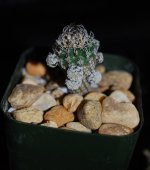entheogenic-gnosis
Rising Star
Turbinicarpus pseudomacrochele var. Krainzianus
Mescaline 2.48%
Turbinicarpus schmeidickeanus spp. Schwarzii
Mescaline 1.26%
250-500mgs of total alkaloid fraction per 100g fresh plant material
This information was derived from "cactus chemistry by species - K. Trout and friends"
PDF files of this publication, as well as many other publications, are available here:
These two cactus species caught my eye.
By all means they should both be suitable as entheogens, yet these two species are never mentioned by most.
Has anybody had any personal experiance regarding the cultivation or Entheogenic consumption of these two species? Any information would be much appreciated, this is all for research purposes of coarse, however as a cactus collector I would love to add these two novel species to my collection, there are no legal restrictions regarding these species (as far as I can tell) however finding the specific species has proven to be quite the task...
(The multiple Latin names causes confusion when looking to purchase these species online, you will find the correct Latin names in the wrong order, or there will be two correct Latin names and the third is something different...while browsing the web I was very specific in my nomenclature regarding the very specific species I was seeking, yet such specificity could not be found on the other end, even when it comes to research regarding these species things become difficult, with enough effort I'm sure I could obtain specimens for my collection, and could locate the proper research information, but that's not what this thread is about... )
Any information, anecdotes or comments would be appreciated, as I have just begun my research involving these cacti and know very little at the present moment.
Thanks,
-eg
Mescaline 2.48%
Turbinicarpus schmeidickeanus spp. Schwarzii
Mescaline 1.26%
250-500mgs of total alkaloid fraction per 100g fresh plant material
This information was derived from "cactus chemistry by species - K. Trout and friends"
PDF files of this publication, as well as many other publications, are available here:
These two cactus species caught my eye.
By all means they should both be suitable as entheogens, yet these two species are never mentioned by most.
Has anybody had any personal experiance regarding the cultivation or Entheogenic consumption of these two species? Any information would be much appreciated, this is all for research purposes of coarse, however as a cactus collector I would love to add these two novel species to my collection, there are no legal restrictions regarding these species (as far as I can tell) however finding the specific species has proven to be quite the task...
(The multiple Latin names causes confusion when looking to purchase these species online, you will find the correct Latin names in the wrong order, or there will be two correct Latin names and the third is something different...while browsing the web I was very specific in my nomenclature regarding the very specific species I was seeking, yet such specificity could not be found on the other end, even when it comes to research regarding these species things become difficult, with enough effort I'm sure I could obtain specimens for my collection, and could locate the proper research information, but that's not what this thread is about... )
Any information, anecdotes or comments would be appreciated, as I have just begun my research involving these cacti and know very little at the present moment.
Thanks,
-eg

